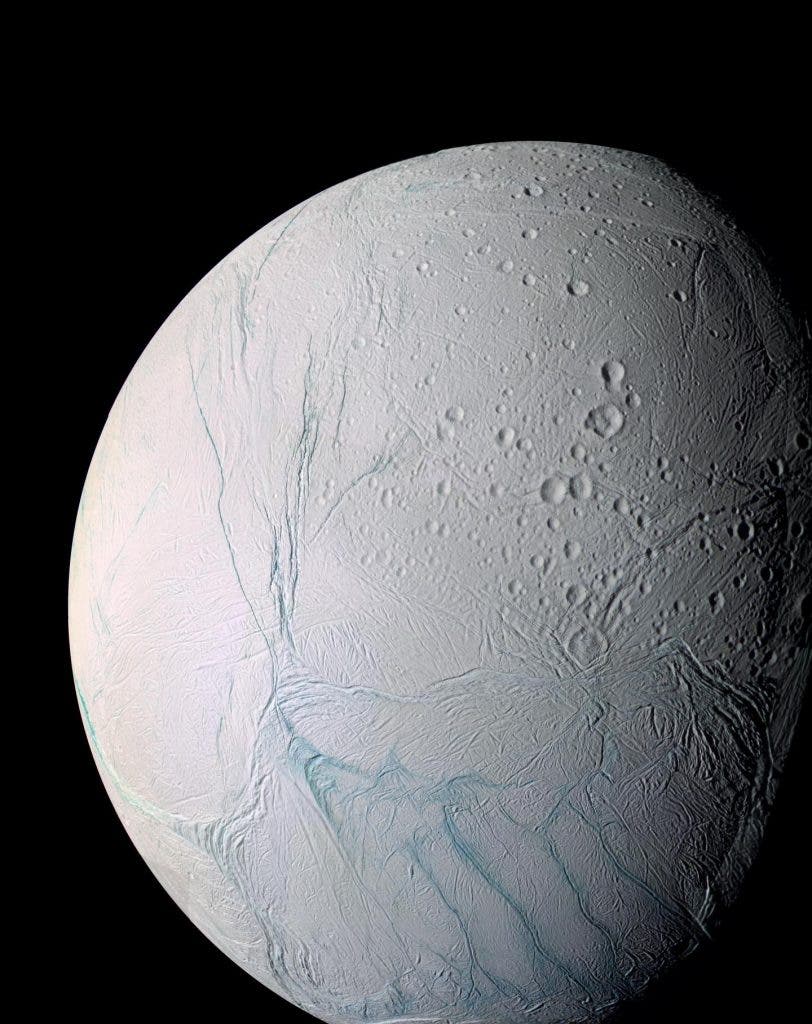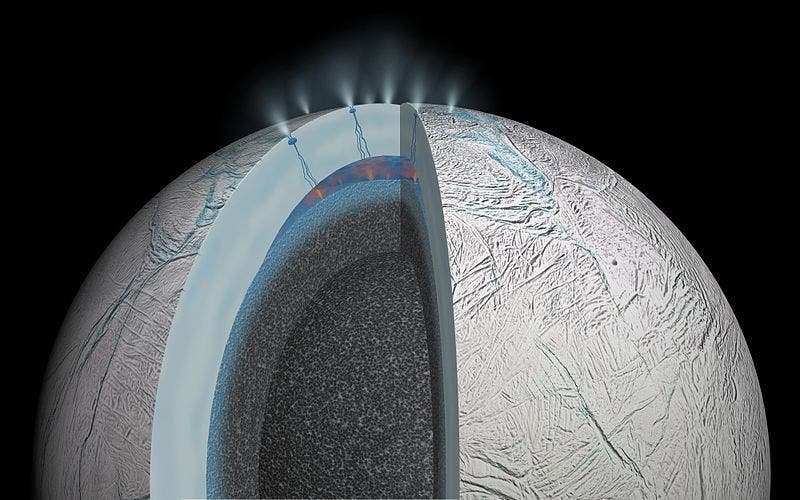A few years ago, the Cassini spacecraft made a surprising discovery: there are geysers erupting on Saturn’s moon Enceladus, spewing water and ice to great heights. However, the process which causes these geysers remained unknown or controversial. Now, scientists at the University of Chicago and Princeton University have pinpointed a mechanism through which Saturn’s tidal forces exert constant stress and cause long-term icy eruptions.
Ice and volcanoes

This enhanced color view of Enceladus shows much of the southern hemisphere and includes the south polar terrain at the bottom of the image. Scientists at the University of Chicago and Princeton University have published a new study describing the process that drives and sustains this moon of Saturn’s long-lived geysers. Photo by NASA/JPL
Enceladus is is the sixth-largest moon of Saturn, measuring only 500 kilometers (310 mi) in diameter. Enceladus is covered by fresh, clean ice, reflecting almost all the sunlight that strikes it. However, Enceladus displays a surprisingly large variety of geological features, including rifts, canyons, grooves, ridges and fractures, likely caused by the stress exerted on the moon by its parent planet, Saturn. This stress also causes massive friction inside the planet, which led researchers to believe that there might be a liquid ocean under Enceladus’ frozen surface — and potentially, life. Disregarded once as frozen and barren wasteland, the moon is now one of the likeliest places to find extraterrestrial life.
But one big question still remained: why are these eruptions happening in the first place?
“On Earth, eruptions don’t tend to continue for long,” said Edwin Kite, assistant professor of geophysical sciences at UChicago, who led this study. “When you do see eruptions that continue for a long time, they’ll be localized into a few pipelike eruptions with wide spacing between them.”
Enceladus has multiple fissures along its south pole. These “tiger stripes” have been erupting for decades, and it’s strange that the geysers haven’t clogged up on themselves. Somehow, these icy eruptions kept going and going.
“It’s a puzzle to explain why the fissure system doesn’t clog up with its own frost,” Kite said. “And it’s a puzzle to explain why the energy removed from the water table by evaporative cooling doesn’t just ice things over.”
Kite suspected there was another source of energy, responsible for cleaning the site. Now, after creating several models of the site, they believe they’ve zoomed in on this factor:
“We think the energy source is a new mechanism of tidal dissipation that had not been previously considered,” Kite said. Kite and Princeton’s Allan Rubin present their findings the week of March 28 in the Early edition of the Proceedings of the National Academy of Sciences.
Life beneath a frozen moon

: Possible Hydrothermal Activity (Artist’s Concept)
This cutaway view of Saturn’s moon Enceladus is an artist’s rendering that depicts possible hydrothermal activity that may be taking place on and under the seafloor of the moon’s subsurface ocean, based on recently published results from NASA’s Cassini mission. Credits: NASA/JPL
Understanding this system is extremely important for astrobiological studies (the search for extraterrestrial life). As I mentioned above, Enceladus is one of the top candidates for extraterrestrial life. Kite even calls it “an opportunity for the best astrobiology experiment in the solar system,” and for good reason. Not only is it extremely likely that it hosts an ocean of liquid water, but Cassini’s data indicates that the icy volcanoes probably originate in a biomolecule-friendly oceanic environment.
The erupted plumes have been shown to have grains of silica-rich sand, nitrogen (in ammonia), nutrients and organic molecules, including trace amounts of simple hydrocarbons such as methane. All these are indicators of hydrothermal activity in Enceladus’ ocean; hydrothermal vents are generally regarded as ideal places for life to thrive. To make things even better, models indicates the large rocky core is porous, allowing water to flow through it to pick up heat.
Europa, one of Jupiter’s moons is in a very similar situation, and the team now wants to apply similar models for it.
“Europa’s surface has many similarities to Enceladus’s surface, and so I hope that this model will be useful for Europa as well,” Kite said.
Robotic exploration missions have been planned for both moons, but no clear timeline has been drawn.









